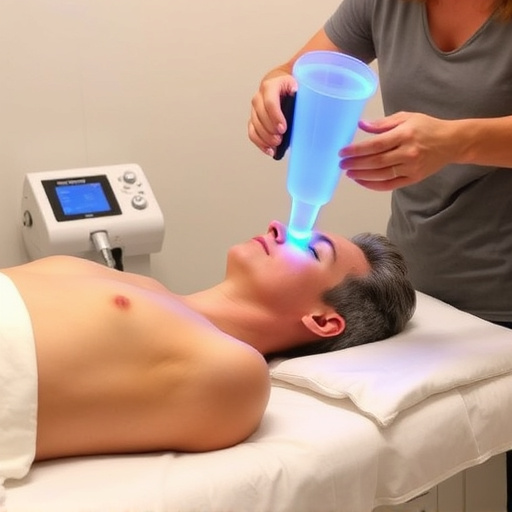Shockwave plantar fasciitis treatment significantly reduces pain and improves foot flexibility, offering swift recovery and decreased inflammation. Healthcare professionals use objective tools like the Visual Analogue Scale (VAS) and manual assessments to track progress, supporting therapy's effectiveness for chronic pain management and post-accident rehabilitation. This non-invasive approach expedites healing, enhances mobility, and fortifies feet against future injuries.
“Are you tired of persistent plantar fasciitis pain? Shockwave therapy offers a non-invasive solution with promising results. This article explores the key indicators that demonstrate the effectiveness of shockwave plantar fasciitis treatment. By measuring improvements in pain levels, tracking foot flexibility, and observing recovery times, patients can gain insight into their progress. These metrics highlight the success of shockwave therapy in reducing inflammation and restoring mobility, offering a glimmer of hope for those seeking relief from this debilitating condition.”
- Measuring Improvement in Pain Levels
- Tracking Foot Flexibility and Mobility
- Observing Recovery Time and Inflammation Reduction
Measuring Improvement in Pain Levels

Measuring Improvement in Pain Levels is a crucial aspect of understanding whether shockwave plantar fasciitis treatment is effective. Patients often experience significant relief from pain and discomfort after undergoing this non-invasive procedure. One of the primary indicators of success is a noticeable reduction in the intensity and frequency of pain associated with plantar fasciitis. This can be assessed through patient self-reporting, where individuals rate their pain levels on a scale before and after treatment. A decrease in pain scores suggests that the shockwave therapy is working to reduce inflammation and promote healing in the affected areas.
Additionally, clinical evaluations by healthcare professionals play a vital role in monitoring progress. They may use specific measures like the Visual Analogue Scale (VAS) to gauge pain perception objectively. Over time, as symptoms subside, patients are likely to report lower VAS scores, indicating improved comfort and mobility. This data, combined with patient feedback, provides compelling evidence that shockwave plantar fasciitis treatment is indeed effective in managing pain and enhancing overall foot health, effectively addressing the root causes of this common condition, including post-accident rehabilitation for soft tissue injuries.
Tracking Foot Flexibility and Mobility

Tracking foot flexibility and mobility is a crucial aspect of managing shockwave plantar fasciitis. As the condition improves, patients often experience increased range of motion in their feet and ankles. This can be measured using various techniques, such as manual muscle testing or dynamic stretching exercises. A trained healthcare professional can guide you through these assessments, helping to quantify your progress over time.
By regularly monitoring foot flexibility, you can gain insights into the effectiveness of your treatment plan. If sciatica relief is part of your recovery goal, improved mobility will contribute significantly. Moreover, enhancing foot flexibility not only aids in pain management but also reduces the risk of future soft tissue injuries, ensuring a more robust and resilient foot structure.
Observing Recovery Time and Inflammation Reduction

One of the most evident signs that shockwave plantar fasciitis treatment is effective is the significant reduction in recovery time. If you’ve been experiencing this condition, you know how debilitating it can be, often leading to prolonged downtime and limited mobility. After starting shockwave therapy, a notable decrease in recovery time will indicate that your body is responding positively. This means you might find yourself feeling less sore and more able to engage in everyday activities without the usual discomfort or pain.
Additionally, inflammation reduction is another crucial indicator. Shockwave plantar fasciitis treatment works by stimulating blood flow and encouraging tissue regeneration, which can substantially decrease the inflammation associated with this condition. As inflammation diminishes, you’ll likely notice a relief from the intense pain and stiffness that characterized your symptoms before treatment. This double-pronged approach—shortened recovery times and lessened inflammation—is a strong testament to the effectiveness of shockwave therapy in managing chronic pain and fostering mobility improvement.
When treating shockwave plantar fasciitis, tracking key indicators like pain levels, foot flexibility, mobility, recovery time, and inflammation reduction is crucial. If you observe consistent improvements in these areas over time, it’s a strong testament to the effectiveness of your treatment plan. Remember that every patient is unique, so closely monitoring these metrics allows for personalized adjustments to ensure optimal recovery. In summary, by focusing on these key indicators, you can effectively navigate your journey towards relief and reduced shockwave plantar fasciitis symptoms.














